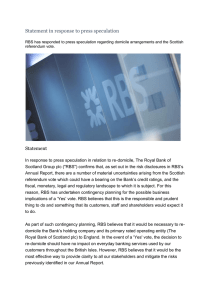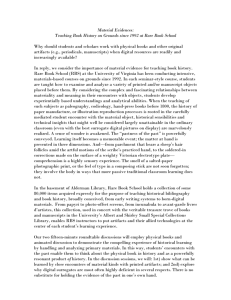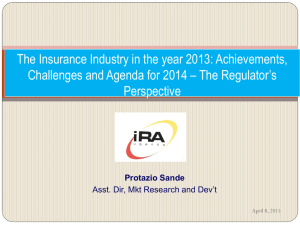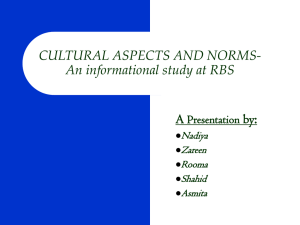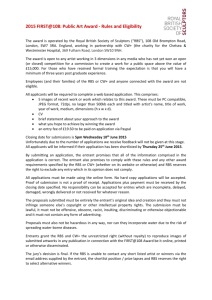S1 Electronic Supplementary Material Design of a recombinant
advertisement
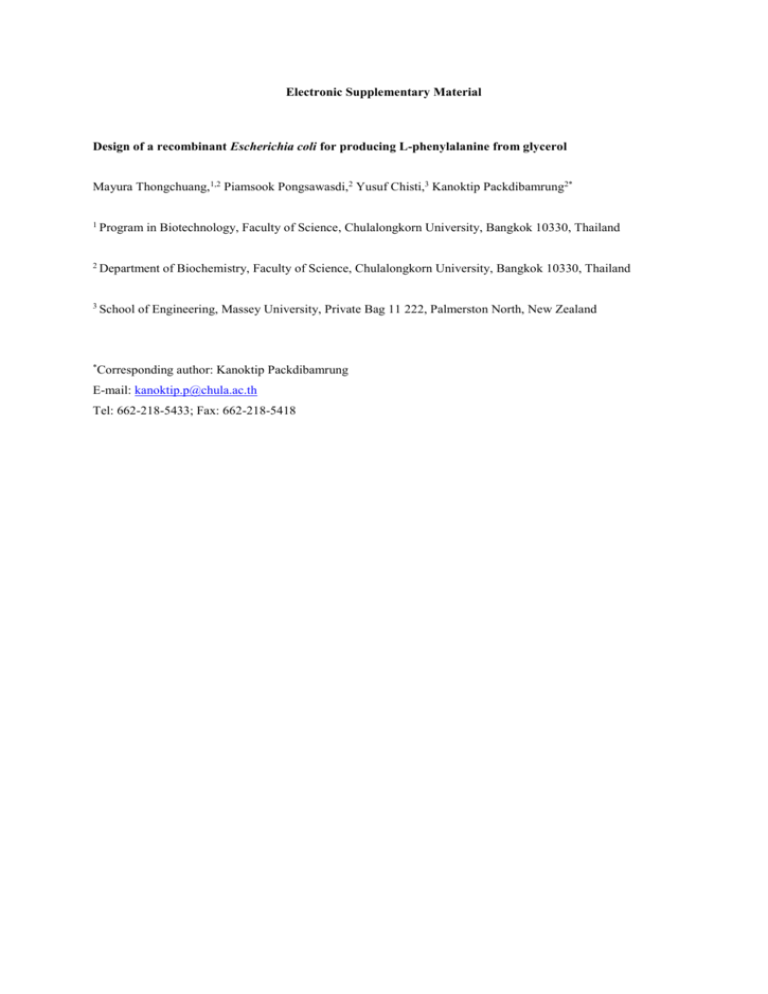
Electronic Supplementary Material Design of a recombinant Escherichia coli for producing L-phenylalanine from glycerol Mayura Thongchuang,1,2 Piamsook Pongsawasdi,2 Yusuf Chisti,3 Kanoktip Packdibamrung2* 1 Program in Biotechnology, Faculty of Science, Chulalongkorn University, Bangkok 10330, Thailand 2 Department of Biochemistry, Faculty of Science, Chulalongkorn University, Bangkok 10330, Thailand 3 School of Engineering, Massey University, Private Bag 11 222, Palmerston North, New Zealand * Corresponding author: Kanoktip Packdibamrung E-mail: kanoktip.p@chula.ac.th Tel: 662-218-5433; Fax: 662-218-5418 S2 Supplementary Methods Subcloning of phedh gene to pRSFDuet-1 vector The phedh gene from B. lentus (GenBank accession no. EU880599) was amplified with the forward primer phedh-NdeI and the reverse primer phedh-EcoRV using previously constructed pBLPheDH (4,388 bp), pET-17b inserted with B. lentus phedh under T7 promoter, as the template. The putative phedh was harvested by Gel/PCR DNA Fragment Extraction Kit (Geneaid, Biotech Ltd, Taiwan). The purified fragment digested with NdeI and EcoRV was ligated at the same sites of pRSFDuet-1, resulting in a recombinant plasmid pPheDH (Supplementary Fig. S1). After transformation into E. coli BL21(DE3), the recombinant clones were screened on LB agar plates containing 30 g/ml of kanamycin and incubated at 37 C for 18 h. The inserted phedh gene was verified by DNA sequencing at Macrogen Inc., Republic of Korea. Cloning of individual yddG and glpF genes into pRSFDuet-1 vector The primers used for PCR amplifications of yddG (yddG-NdeI and yddG-XhoI) and glpF (glpF-NdeI and glpF-PacI) were designed based on the nucleotide sequence of each gene from E. coli DH10B (GenBank accession no. CP000948.1), a strain with a close similarity to the strain TOP10. After the E. coli TOP10 genomic DNA had been isolated (Federick et al. 1995), it was digested with BamHI and used as template for yddG and glpF amplification. The PCR products obtained (i.e. yddG and glpF fragments) were digested with respective NdeI-XhoI and NdeI-PacI restriction enzymes together with pRSFDuet-1. Each gene was ligated into pRSFDuet-1 to produce the recombinant plasmids pYddG and pGlpF (Supplementary Fig. S1) and then introduced into E. coli BL21(DE3). The E. coli BL21(DE3) clones containing the correct nucleotide sequences of each gene were examined for gene expression. Cloning of yddG and glpF genes together with phedh in a single vector The DNA fragment containing the T7lac promoter, the ribosome binding site and the yddG gene was amplified from pYddG using primers T7-AscI and yddG-HindIII designed from T7 promoter-2 sequence of pRSFDuet-1 and 3’-sequence of yddG gene, respectively. This fragment was cloned into AscI and HindIII sites S3 of pPheDH leading to pPY containing phedh and yddG genes (Supplementary Fig. S1). Similarly, the glpF gene fragment was amplified from pGlpF using primers T7-XhoI and glpF-PacI and then cloned into XhoI and PacI sites of pPY to produce pPYF containing phedh, yddG and glpF genes (Supplementary Fig. S1). The plasmids pPY and pPYF were separately transformed into E. coli BL21(DE3). Reference Federick MA, Roger B, Robert EK, David DM, Seidman JG, John AS, Kevin S (1995) Short Protocols in Molecular Biology, 3rd edn. John Wiley & Sons, USA S4 T7-1rbs lacI MCS-1 T7-2 rbs pPheDH (4,955 bp) ori kn lacI phedh EcoRV Ter T7-1 rbs pYddG (4,657 bp) T7-1 lacI MCS-1 T7-2 rbs ori NdeI rbs MCS-1 T7-2 rbs NdeI pGlpF (4,546 bp) ori yddG glpF XhoI kn Ter AscI T7-1 T7-2 rbs lacI PacI kn Ter AscI T7-1 T7-2 rbs yddG lacI yddG HindIII HindIII pPY (5,931 bp) ori NdeI T7-2 rbs NdeI pPYF (6,817 bp) ori T7-2 rbs NdeI phedh phedh kn EcoRV kn Ter EcoRV T7-2 XhoI rbs Ter PacI glpF Supplementary Fig. S1 Structures of the recombinant plasmids pPheDH, pYddG, pGlpF, pPY and pPYF.

